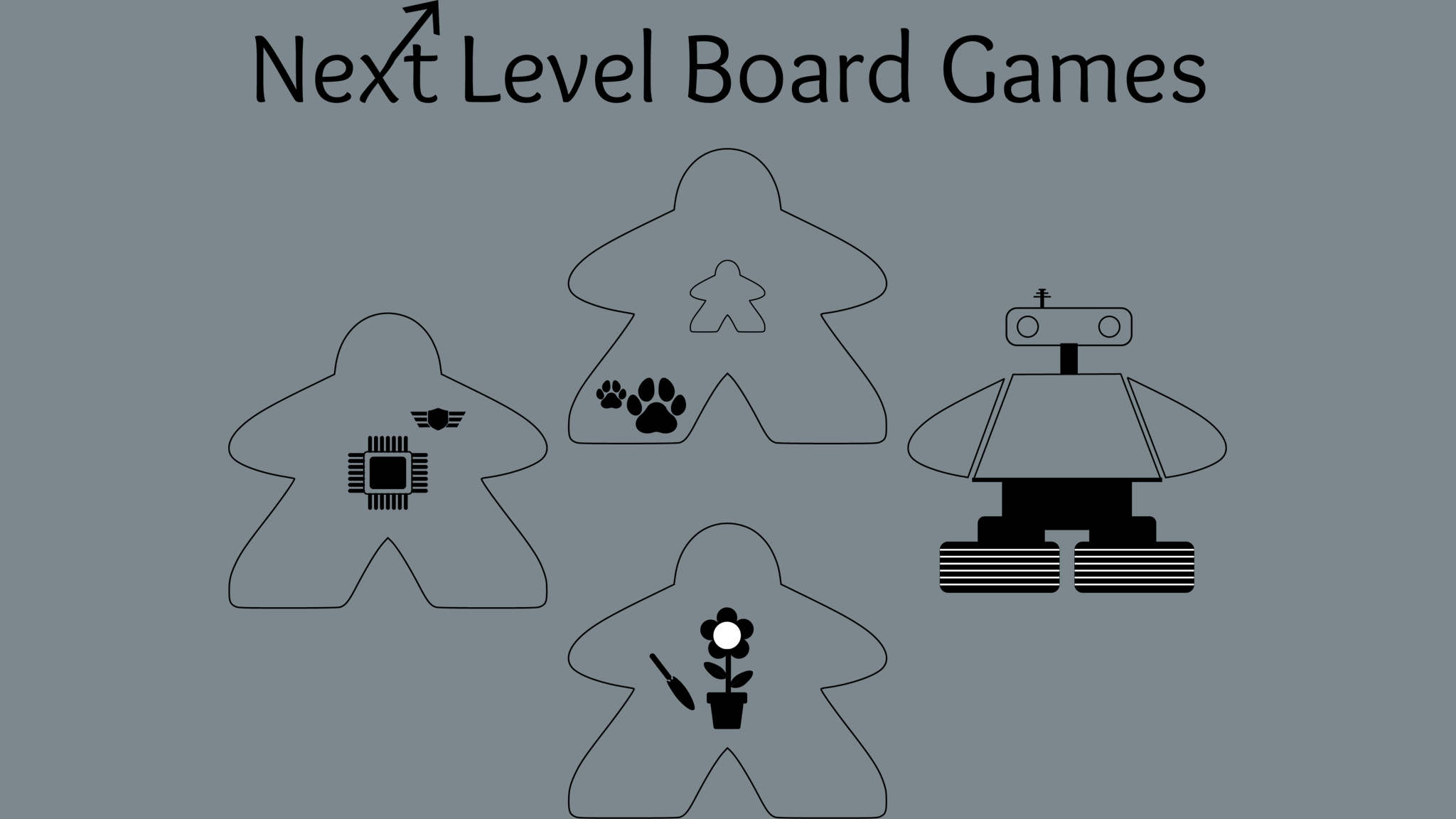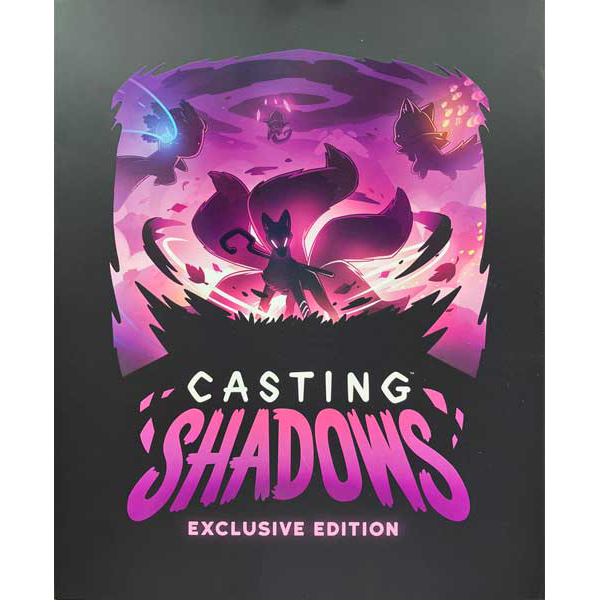Casting Shadows is a game publisehd by Unstable Games. The premise of the game is for players to play as characters who begin in a base form, but who can later be upgraded to a more powerful shadow form. Character boards are two-sided and shadow forms have unique abilities. Players roll dice for resources each turn and use these to acquire cards that can protect them from attacks, attack other players, or modify their dice results. The game continues until only one character remains.
To see what all is included in the deluxe version of this game, watch our unboxing video:
This post is broken into the following 3 sections, feel free to jump directly to one:
- General summary - consisting of information about overall enjoyment, theme, replayability, and upgrades
- Complexity - consisting of information about the rulebook, setup, player turns, and overall learning curve
- Player turns - consisting of game type, game flow, rule you are likely to miss, and favorite aspect
General Summary
Number of players we had: 3
Our play time (not including setup): 40 minutes
Table size needed: Small (3')
Special considerations: If you have anyone with memory issues, keep the tile reference sheet close by so they can see what benefit is available when beginning on each of the hex tiles.
Overall Enjoyment

Overall our group enjoys this game even though it is a combative game, which we typically do not choose. However, Casting Shadows has a good balance between unique cards, resource gathering, planning and a bit of luck. Players can acquire attack and conversion spells which help attack other characters and better use their dice rolls each turn. Additionally, counterspell cards provide benefits in conflict and even though they take a space in a player's area, the benefit is unknown until the card is revealed.
One of our favorite things about this game is the balance. Each player can only have six cards at any one time, including a companion animal if you have one. This limit helps prevent one player from acquiring a bunch of really strong cards that allow them to run away with the game. Companion animals provide all kinds of benefits, but can take time to earn, being collected when a player switches their character into shadow form.
Additionally, some higher costing cards might provide a stronger attack, but with more limited use. This, in addition to the card limit, means players really need to be strategic about the cards they collect.
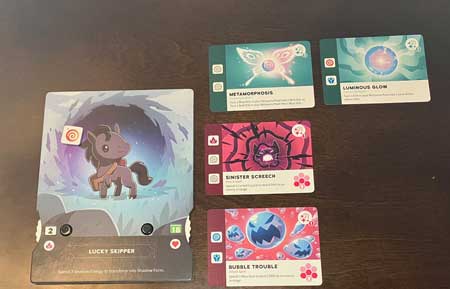
We also love how the main color on the cards is based on the card type. Companions have a purple theme, counterspells are yellow, conversions are blue and attack cards are pink/magenta. Even though this game is a fight until the end, the theme keeps it from feeling overly aggressive.
Lastly, we love the unpredictability that is naturally introduced by the rules. Rolling dice to determine available resources each turn means every player has the same chance to get what they need, or to fail to roll what they need. Another randomness the game introduces comes from counterspells, which vary greatly, and are hidden from other players. A player can see that another character has a counterspell, but they have no idea what benefit it provides until that character reveals it after a fight is initiated against them.
If I had to pick one thing we did not like about this game, it would be that the benefit of starting on each hex tile is not displayed directly on the tile. It is not easy to memorize all of the benefits so players have to constantly reference the cheat sheet. I think this information could have been included on the tiles since the descriptions are not long. I suspect they were left off so they did not conflict with the artwork, which I can appreciate, but it did slow the game flow for us a little bit. This can also be super challenging for any players with memory issues.
Theme

The theme of this game is animals and fantasy. Players take on the roles of animal characters that can be upgraded over time.
Replayability

The main form of replayability in this game is provided by the abundance of conversion and attack spells, with a total of 52 cards in this main deck. The Ice Storm Expansion includes an additional 15 main deck cards. Additionally, not all of the hex tiles are used in each game and all but the three provide special benefits when players begin their turn on them. One last thing that increases replayability is that each character's shadow ability is different.
Upgrades

There are a couple of upgrades for this game. The original game comes in standard and exclusive editions. There is also the Ice Storm expansion, which allows for 5-6 players, adds extra abilities, new hex locations, additional cards for the main deck, counterspell deck and companion deck, as well as 2 new characters.
Additionally, other unique characters could be added individually when backing the Kickstarter campaign. I am not sure if these are still available or if they were only during the campaign. However, on the Casting Shadows page on the Unstable Games website, there is a tool to create your own unique player board!
Complexity
Rulebook
The rulebook is very small, consists of a small pamphlet with lots of images and examples of how the game plays. It is well organized and easy to understand, and there is an additional two-page sheet with all of the hex tiles and their benefits.
Setup
Setting up Casting Shadows takes about 5 minutes. This includes setting up the starting hex tiles as well as those that correspond with the characters each player has chosen. Next, players take their double-sided player board with their built-in health and shadow energy trackers as well as their base and shadow form meeples. Lastly, set out resource tokens and dice and you are ready to begin.
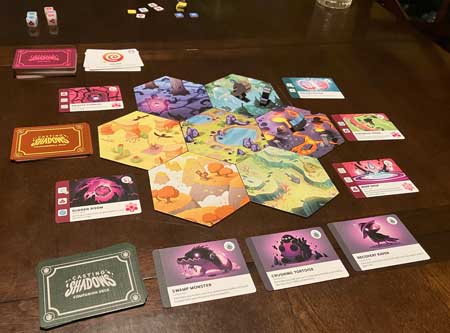
Turns
On their turns players roll the 5 unique dice to see what resources they can use during their turn. The dice have the following available resources:
- Shadow fragments - can be used to acquire certain cards or be saved as shadow energy at the end of a turn to upgrade from your base to shadow form or use the shadow ability.
- Gems/Orbs - used to acquire cards or to activate options on already acquired cards.
- Cursed crystals - reduce health unless you spend an action to protect against it.
Once a player rolls the dice for their turn, they have four action points to spend, which can be used to perform any combination of the following:
- Protecting against a cursed crystal to prevent losing 1 health point.
- Moving to an adjacent hex tile.
- Refreshing a card next to the player's location with the top card of the main deck.
- Collecting a card next to the players location by spending the resources required.
- Casting the spell of an already collected card by spending the resources required.
- Rerolling any number of dice.
At the end of a player's turn, they transform any remaining shadow fragments into shadow energy on their player board and each cursed crystal reduces character health by one. Lastly, any unspent resources are forfeited.
Overall learning curve
The overall learning curve for this game is low. All players have the same actions to choose from every turn, along with the same number of actions. The cards are explained well and easy to read. The biggest challenge we face is remembering what benefit each hex tile provides when our characters begin on that tile. We have found the most success taking advantage of the tile benefits by keeping the pamphlet dedicated to their descriptions open nearby.
Player Turns
Play type
Casting Shadows is a symmetrical, dice-rolling, hexagon grid, player elimination game where players battle one another until only one character remains. The only difference between players is in their shadow form abilities. There is a small amount of luck introduced by the resources being dynamically created every turn. However, cards next to a player's hex tile can be replaced using an action if a player does not have the necessary resources, and all players have the same challenge of unpredictable resources.
Game flow
Players get four actions per turn, but these go really fast, especially when you roll cursed crystals. It is often far more advantageous to protect against cursed crystals and retain health than to use actions for something else. Actions are easy to understand and attacks affect other players which keeps players engaged at all times.
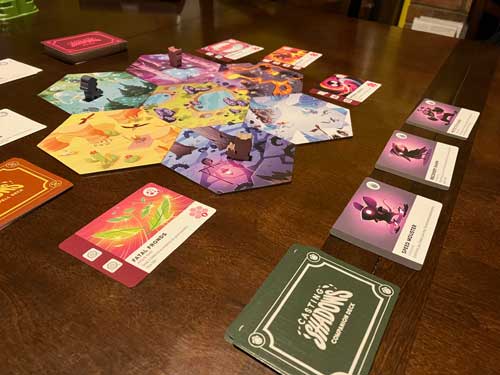
Rule you are likely to forget/miss
The one rule you are likely to forget or miss is that the purple gems and orbs on the dice are wild for the red and blue gems and orbs, meaning they can be used interchangeably for them. Some cards have a purple gem or orb as part of their cost so it can be easy to forget that this does not require a purple gem or orb, rather it means the player can use a red or blue gem or orb to meet the cost.
Favorite aspect
My favorite aspect of this game is the thought put into all the pieces. The dual-sided player boards with the tracking wheels are extremely well done. The art on the cards is wonderfully color-coded making it super easy to identify companions, conversion spells, attack spells, and counterspell cards. I also really like the art on each card and the color schemes, as well as having meeples to match both the base and shadow forms.
Overall, we like this game even though our group is not typically a big fan of fighting games. We like the randomness of all of the types of cards you can collect, the limit on the number of cards players can have, the art, and how the theme makes the fighting not seem as aggressive as it could otherwise.
